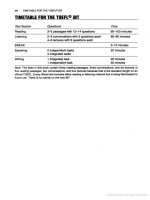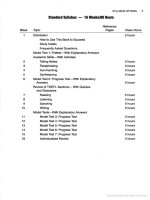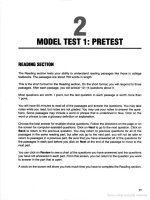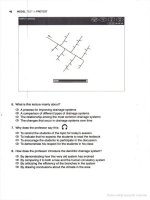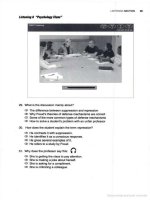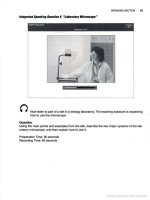Toefl ibt internet based test 2006 - 2007 part 71 pdf
Bạn đang xem bản rút gọn của tài liệu. Xem và tải ngay bản đầy đủ của tài liệu tại đây (1005.02 KB, 7 trang )
526 ANSWERS AND AUDIO SCRIPTS
FOR
ACTlVmES,
QUI
ZZE
S,
AND
MOOEL
TE
STS
1. 0
2.
A
3 . •
• • A
5. C
6 . •
7. A
8.
C
s.
,
According to the lecturer, fossils ciorumenl the evolutoo of the
ho
rse
, providing
in
formalion aboul
the climate
and
migrat
ion
patterns. Geologists claim that horses appeared
on
Earth millions of yea
rs
before
hOOlll
n
be
ings. A horse known as the ardlltheres
had
migrated to Europe
In
the Miocene f
rom
North
Ame
rica. Following the
same
route,
the
hlpparion migrated to Europe tater In the
Pt
iocene.
When
the
hlpparion invaded Europe, the anchitheres did not survive. In contra
st,
the hipparion developed Into
a sturdy animal,
li
ke
modem breeds 01 horses. Ironically, horses
were
already
e~t
l
nct
In
North
Am
&rica
by the Pleistocene. and Europeans
ret
urned the horse to the American colonies on snips.
1. 1IadI.,
50% The function and
re
sponsibilit
ies
of
th
e
Fed
40%
The composition
of
the
Fed
1
0%
A comparison 01 t
he
Fed
to
a fourth branch
of
govemment
Although lhe summary below
Is
actually closer to
50%
,
~,
20%
. it
stil
l mainta
in
s a reasonably accu·
rale emphasis.
s
,
The
fu
nction of the Federal Reserve System
is
to regulate
money
aod
credit by
bUying
aod selling
government securities,
thereby Influeoclng periods of recession
and
In
!tat
oo
. Moreover,
the
Fed
c0op-
erates
with
the
Department of the Treasury to Issue
new
coins and paper
no
t
es
to
ban
ks and particl·
pales In international financiat
policies through member banks overseas.
The F
ed
Inclu
des lwetve district reserve banks and branches. all national commercial banks and
credit unions.
as
well
as
several committees and councils,
Inc
lud
i
ng
t
he
powerful board 01 governors
appointed
by
the President.
Because
of its powerful membership,
the
Fed
has been compared
to
a fourth branch of govern·
ment, bvI the President
's
policies
are
usually Implemented.
)pynghlOO
mater I
ANSWERS
ANO AUO
IO
SC
RIPTS
FOR
PRACTICE
ACTIVITIES
IN
CHAPTER
3
52i
10
store water,
an
opening where the water
can
shoot
up
, and
cracks
in
the ground for the water to
go
back
down
inlo a pool.
Geysers
are in
New
Zealand, Iceland, and the
United
Stales.
Old
Faithful in
Yellowstone
Is
the most famous geyser,
56
."
This
Is
a
good
summary. The oonlenl is accurate, and all the major points are
included
. The problem
here
is
thatlhe
writer did noIloIlow the order in the original so the points are
not
In the
same
sequence
and they are difficult
to
follow
. •
So:
.
,2
This
Is
a good summary
becaU$8
it
is
briel,
Il$eS
the
same
organization
8$
the
original.
includes
the
major
points, reports the oontent accurately, paraphrases using the summarizer's
own
worcIs
, and maintains
an
objective point
01
view
that
does
not
include the opInloos
01
the
person
summarizing the Original.
s .
,S
This
is
not
raally a su
mmary
01
the
original passage. Instead of a factual report, th
is
paragraph Includes
opinions
and judgments
tha
i the original author did
001
express.
ThiS
su
mmary is
not
paraphrased. Sentences
are
copied
from
the original. The summary would
not
be
scored. and
00
cr
edit would
be
assigned
.
Th
is
is
the most serious problem In summarizing.
SIt
e.y
5
The
problem
In
ttvs
summary
is
the
empha
sis. Too much attention Is given
to
In
formation
in the first
paragraph
of the
OrigInal
re
adrig
, whereas points from the second
paragraph
are
not
included
.
Facts
from the third
and
fourth paragraphs are
only
brielly
mentioned
.
"""""
AI:rmrr
31
1. Summarize the points In the lecture,
eJCplal
ning
how
they
su
pport the data In the reading.
2. Explain the model described In the
read~
.
and
then
shoW
how
the lecture contradicts
It
.
3. Exptalnlng
how
they provide evidence
for
the Information In the reading, summari
ze
the points
made in the
lecture
you
nave j
usl
heard.
4. Summarize the hypothesis oullined In
the
reading, explaining
how
the lecture supports It.
5. Summarize the
major
points in the
reading
, expiaining
how
the lecture COfllradicts them.
6. Explain
how
the lecturer's
view
substantiates the opinions expressed
in
the readioo.
7. Summarize the points made in the lecture you have just heard, explaining
how
they differ from
the
poin
ts
made in the reading.
8. Summarize
the
points
from
the
lec!ttre, explaining
how
they
cast doubt
on
the reading.
righted aler
53(J
ANSWERS
AND
AUDIO
SCRIPTS
FOR
ACTIVITIES.
OUIZZES.
AND
MODEL
TESTS
9. Referring
to
the main points
in
the lecture, summarize
the
professor's opinion, contrasting
It
with
the views elqlressed
In
the
reading,
to
. Summarize the coocept
in
t
he
reading, referring
to
the examples provided
in
the
lecture
you
have
just heard.
1. Summarize the points that the lecturer makes, explaining how they
$IJpnnrt
the Information
In
the
read
i
ng.
Agreement
2.
Explain the theory proposed
in
the reading,
and
then
OO!Jtrasl
the Ideas In the theory
with
the
views
expressed
In
the
lecture.
DIsagreement
3. Summarize the points
macle
in
the
lecture
you
have Just heard, explaining how they suppo
r1
the
information
in
the reading.
Agreement
4.
Referring
to
the main points
In
the lecture, summarize
the
professor's views,
OO!Juasting
them
with
the opinion expressed
In
the
reading,
Disagreement
5 . Summarize the hypotheSis outlined in
the
lecture, explaining how
the
reading casts
dpubl
on
its
velidity.
Disagreement
6.
Summarize the points
in
the lecture
you
have
Just
heard
, referring
to
the
e!t8mOles
provided
In
the
reading.
Agreement
7. Summarize
the
major points
in
the
readi
ng
, explaining how the lecture coptradic1s them.
Disagreement
8, Explain
how
the
lecturer's Ideas differ from
tho$e
In
the
reading.
DIsagreement
9.
Summar
ize
the points
made
in
the
iecttJre
you
have
Just
heard,
elCplalnlng
how they reinforce
the
points mads in!he reading.
Agreement
10. Summarize the points from
the
Ject\jre,
elCplainlng
how they
1":.1111
doob!
on
the
reading.
Dlsagreemen.
1. Primery source: The advan.ages of cooperative learning
In
schools
Advantages
Secondary source: The disadvantages
of cooperative learning
in
schools
Disadvantages
2. Primary source: All explanation oIlheoretieallinguistics
Explanation
Secondary source:
All explanation
of
applied
~nguiSliCs
Contrast
3. Primery source: The eradication
of
diseases on a
world-wide
basis
Issue/SituatiOrVProbIem
Secondary source:
The Workl Heanh Organization's campaign agalnsl smallpox
SoIutiOnlExample
lpynghl maklr I
ANSWERS
AND
AUDIO
SCRIPTS
FOR
PRA
CTICe
Acnv
m
es
IN CHAPTER 3
531
4. Primary source:
The
problem
of
noise pollution in a lactJnoIogical society
P"""'m
Secondary source: European noise ordl!"l8nces thai Ilmij noise pollUllon
SoIution/Exampia
5. Primary source: Advertising products abroad
Coo<o~
Secondary source:
The
marbling
plan for Toyota In
the
United States
Case
Study
6. Primary source:
The
theory
01
flow
Thoo<y
Secondary source: A Harvard University study on
flow
Research Study
7. Primary source:
The
impact
01
a larga meleor
on
Earth
Cause
Secondary source:
The
disappearance
of
dinosaurs after the meteor
Result
8. Prim8Jy source: Nuclear power plants are dangerous
Opinion
Secondary source: Nuclear power
is
a good source
of
energy
Contrasting opinion
9.
Primary source: Oualitativa research designs In the social sciences
Thoo<yiCo«ept
Secondary source:
The
Hawthorne eHect
as
a limiting lactor In qualitative research
Research Studyl
ExampielOlsadvantage
10. Primary
source:
The
sIZe, price,
and
power
01
earty c:ompuIers
IssueJSUuation
Secondary source:
The
sIZe, price,
and
power
01
modem computers
ComparlsonlContrast
n
Acllvlty
34, CD 3,
Track
2. Usten to part
of
a leCIure
in
a biology class.
People call
it
a bear,
buI
the koala
is
really a marsupial. So, II
is
much
more
like a kangaroo than
ills
like
a bear. Here·s what I mean. First.
the
koala has a gestatiOn periOd
01
only about
35
days belore it
Is
born.
Then
a tiny pirlk, f
ur1&s9
creal
ure
about 19 mimmel8f51ong makes its way lrom the birth canal into
the mother's pouch
where
It
attaches Itself to one
of
two
nipples. So It stays In the pouch to oomplele it
's
developmenl, and six
to
seven
months
laler, it pokes lis head ouI
and
explores e short distance from the
mother,
Ju
mping back into
the
pooch
un~11t
reaches eight months
wtlen
I!
Is too big
to
fl!,
and
l
or
another
l
our
months
I!
r\cIes
on the mother's
back
or
hangs from hef stomach until
It
lil"lally becomes indepen-
dent
at about one
yearold
. By !hen,
ills
about
the
same size
as
a Taddy Bear and looks remarkably like
one, with
a furry coat, rounded ears and a large nose
10
support lis keen senses
01
smell
and
hearing.
Native to Australia,
the
koala lives In Irees
and
Is
a skillful climber. II sleeps in
the
branches during the
day
,
and
at nlghl,
I!
combs the trees for Ita laVOrite
meal-eucalyptus
leaves.
)pynght mater I
532 ANSWERS AND AUDIO SCRIPTS FOR ACTI
VmES
. QUIZZES. AND MODEL TESTS
1.
What is
the
primary source? The reading about marstlpials.
2. What is
the
secondary source?
The
lecture about koalas.
3. What
Is
the
task? A
synthesis
IOf
extension
Of
lor contrast? extension.
4.
What
is
the
SpecifIC
relationship between
the
primal)'
and
seconde.ry
soorces? A
definition
and
an
ell8mple.
Marsupials
are mammals that are distinguished
by
the way that they complete their embryonic
clevelopmenl. Marsupials
emerge
alter a short gestation
and
lind
the
ir way
from
the birth canal
to
the
mother's pouch, where they attach themselves to one of tha nipples to nurse until they
are
ruDy
devel-
oped. Marsupials
are
not prone
to
fami
ly
groupings. but
the
young stay with the mother lor a year
Of
longer.
Althou
gh
marsupials were once abundant
on
sever
al
continents. today there
are
lew outslde of New
Zealand and Australia where
more
than 250 species may still
be
found. Some
01
the characteristics that
they share
are
a keeo seose of smell and hearing. which are important
10
their nocturnal
naMe
,
and
additional pelvic bones thaI
StJpport
the
pouch
.
t.
Transition sentence
to
conned one ooocept with another ooncept
In
a comparison.
In
comparison.
a bIome
Is
a major regional ecosystem. AccordIng
to
the lecturer, . . .
2. Transition
se
ntence
to
connect a concept
with
an
example.
An
Mample
011111
innovation in
induS-
trial production In the 19th century
i:i
Henry Fool's assembly li
ne
. According to the lecturer •
3. Transition sentence 10 connect the advantages with the disadvantages.
00
the other
hand,
stone
has several d
isadV
antages. Accordi
ng
to the read
ing
•
4.
Tr
ll11sition
sentence to conned one concept with another
In
a contrast
In
contrasl agrarian s0ci-
eties cultivate crops
with
draft animals and plows. According
to
the
lecturer, .
5.
Transition sentence
to
connect
a cause
(8
Nino)
with
an
effect
(changes
In
d imate).
EI
N
ino
max
have caused the changes in
the
climate of the North American coastline. According
to
the lectur8l',
6.
Transition sentence to conned a buSiness concept with a case study of a restaurant franchise. The
Kentucky
Fried
Chicken chain
is
R
rase
study
pi
franchises. According 10 the lecturer,
1.
Transition sentence to connect a ooncept
with
a research study. A research
stu<tJ
on risks fOf heart
problems was CIIrried
out
with Type A
and
Type B
pe
rsonalities. According
to
the study,
8. Transition sentence to connect
one
opinion with
811
opposiog opinion. The case that the United
States should
oonv8f1
to metrics is strong.
Howeyer
B
rase
maY
be
made l
or
!be
oooos;ng
view
tha
I
the
United States should relaln the English system. According
to
the
reading,
.•.
9.
Transition sentence
to
connect.
a
concept
with
an
example.
An
example 01 South AfrIca's natural
resources
is
gold. According to the lecturer,
IJOId
mini
ng
10. Transition sentence
to
conned a problem (commuting)
with
a solution
(home
offices). Home
offICes
may offer a sokJlion!or
the
problems associated with commuting
10
work
. According
to
the lecture.
Jpynqhtoo
m
llr
JI
ANSWERS AND AUDIO SCRIPTS FOfI PRACTICE ACTIVITIES
IN
CHAPTER 3
533
PtlA&TICE
Acmm'
31
n Activity 37, CD 3, Track 3,
Now
that
you
have
read
the
explanation
01
human migration pat·
terns In the reading. Nstllfl
to
part
01
a lecture on a similar topic.
Okay, today I want to talk to
you
about a hypotheSis that explains where humans might have evolved
and
how
they might have migrated around the
wOOd.
It
's
an
alternative hypotheSis to the replacement
hypolhesis thai
you
read
about
earllE)(.
it's called the multiregioflal
hypothesis
but
I've also heard it
relerred
to
as the continuity hypothesis.
Now,
according to the IiCillfllists
who
support this
view
, modem
humans spread throughout Eurasia about a million years ago and regional populations retained
some
unique anatomlcalleaturas
IOf
hundredsol thousands 01 years,
but
they also
eKchanged
some Inherited
traits with neighboring populations when they mated with
them.
And
we
call this
eKchange
01
traits 98fI8
flow.
So through
th
is gene
flow,
certain characteristics that
we
consider crucial to modem mankind were
inherited, as.
101'
eKample.
an
Increase
In
brain
size
with an accompanying change
in
the skull. And
and lhis gena
flow
resulted
in
Ihe
avolution
01
the ealty humans whose remains
ara
found fhroughout
Europe
and
Asia as well as
AfriCa
.
Now, scientists
who
support th
is
theory contend that the populations
tha
t migrated were linked by
gene
flow
so
that the
featur"
that
all
pooplo have
In
common spread throughout tho
world.
Tho
rola·
lively slight diff8fences among modem people would
have been caused by hundreds
01
thousands of
years
01
regional evolution. Bul actually,
rese81Che
rs
who
SUPfX>/1
the continuity hypothesis tend
to
locus on the genetic similarities
among
human populations
wOOd·wlde,
not
the differences. We're
rea
lly
amazingly similar
as
a species. And the lossils of archaic and modem humans in some
regiol'lS
do sug.
gest a continuous evolution
in
regionallraits,
like
the cheekbone structure, for e:uunple, which
Is
further
evidence
that modem humans may have evolved over a broad area among multiple groups of human
ancestors.
Sy
Summarize the major points
in
the reading and
eKpla
ln how
the
lecturer casts doubt on
those
points.
According
to
\he replacement hypothesis, also
called
the
Out
01
Al
riCa
hypothe
sis,
modem humans
evolved from a common ancestor
In
Africa.
As
they migrated
to
ASia
and Eurooe. and finally
SPread
throughout the world, they replaced the less evolved populations that they encountered. Proatlor this
hypothesis comes from both genetic and paleontological research,
The
large number
01
genetic:
traits
thai
human populations have
in
common are confirmed by
DNA
investigations
in
mitochondria struc·
tures.
tn addition,
!he
oldest fossils Identified
as
modem human remalns have been discovered
In
AfriCa
.
Nevertheless,
the lecturer casts doubt
on
the replacement theory, offering
Ihe
continuity hypothesis
as an alternative. Also known as
the
multi
regiOnal
hypothesis, the continuity hypolhesis proposes that
advanced human populations migrated and mated with less advanced r
egiOnal
populations, introducing
ne
w traits Into lhese populations. Because the regional populations were not replaced, they
reta
i
ned
some of their unique characteristics. The exchange oIlralts, referred to as gene
flow,
accounts
fOf
the
genetic similarity 01 modem human beings. The retention 01 regional genetic material
eKplalns
why
some
tra
its. such as
Cheel\bone
structure. are limited
to
discrete populations, and casts doubt on the
replacement hypothesis, The fact that modern human remalns are
found
in widespread sites also sup-
pons
the
alternative hypothesis that
the
lecturer presents.
)pynghled
maken
II
S34
ANSWERS AND AUDIO SCRIPTS FOR ACTtVmES, QUIZZES, AND MODEL TeSTS
()
A
ctivity
38, CD 3,
TI'Kk
4.
Now
that
you
have
read the explanation
of
population In
the
reading,
Nsten to
part
of
a lecture
on
a similar topic.
Well. it
is
certainly true that Malthus
has
had
an
III
IOOTlOUS
Impact
on
the
study
of
population,
and
in lact.
many
of
h
is
predictions
about
limitations on population appeared
to
be
true
lor a time. but right
now
the
major
debate
in economic population theory Is bet
eon a
group
who
believes that population
growth
has
reached a critical
mass
and
can
no
longer be controlled through tho events and kHces that Malthus
predicted and,
on
the other side
01
the debate. a
group
thai views
~
control
as
part of a
Ia1ger
dem0-
graphic transition. HlH'e's
wnat
I mean. Demographic transition
is
a model in which large populations
lTIO\Ie
from
Stage
1,
with
\I'IH'Y
nigh birth
and
death rates
li
ke Malthus predicted,
to
Stage 21n
which
the
birth rates remain high but tho death rates begin
to
decli
ne
.
mostty
because
of
progress in
IoocI
produc-
tion, sanitation methods,
and
medical treatment, all o
llhese
modem
advances that oould
not
have
been
predicted
when
Matthus
was
deVeloping his theory. So, the population
grows
vety
rapidly In Stage 2.
Okay, in Stage
3.
population continues to increase because, although the birth rate decreases.
the
death
rate also
decreases
,
so
fewer
people
are born, but they tend to live longer.
Now
Stage 4 is the
point
al
which
the
population Increases very sIowty,
Of
it
may
even start
to
decline because both the
birth
rate
and
death rates
are
even
lower
than in
the
previous
stage
. So
we
see this in
Japan
, Europe,
and
North Amerk:a. In
tact.
In Europe,
we
see
something
that appears
to
be a Stage 5.
In
Europe, the
decline In
the
birth rate
has
dropped
to
a level
01
1.7. whIctlls below
the
2.0 replaooment level lor a oou-
pie. So,
unless
immigration rates
inaease
, Europe's population
may
be
an
Indication
of
Mure
demo-
graphies lor
other
industrialized regions.
Summarize
the
major points In the lecture that
you
have
jus
t heard, explaining
how
they cast
doubt
on
the
Ideas In
the
reading passage.
ADouditog
to
the
lecturer, one
modem
view
asserts that wend population
has
reached
a "critical mass
."
and
the
limiting
Ioro&s
Ma/thus had
poqued
to control
population
, such as war, SlalVBIion,
disease
,
and
disasters.
can
no
longer stem
the
growth
In contrast. another
group
01
EICOI'IOI'rMsts
argues lhat population
control Is part
01
a live
slE1Q8
demograptk
transition model,
From
Stage
1, In IOIttilIarge bifIh rates
and
death rates interact someMlai like
MaIthus
prGdicted
,
populations
move into Stage 2, characterized
by
Y8IY
rapid
gn:tow1h
as
all!SUltol'
impio.ements
in sanitation,
agriculture
, and medicine,
By
Stage 3, both
the
birth
and
death
rates decrease, a
trend
that
oontinues
in
Stage 4 u
the
population
growth
slows
at
even
declines.
At
Stage 5. birth rates
fall
below
repIaoement
levels
, and
even
with
deciI
WIg
death rates,
the
population
begins
to
deaease
. The lecturer notes that
the
industriailed
areas
01'
Japan
and
Nof1tI
Amer-
Ica
are
in
Stage 4, whereas Europe
appears
10
be
rnQ'\/Wlg
from
Stage
4
to
Stage
5.
Since
Malthus pointed
cui
that populations at the highest level
of
the
economy
exerd$e
oontroIs
as
a resull
of
education
and
a desire
to
preserve their standard of living. he did, in a
way
, predict
the
trends
lor the Industrialized
world
:
however
, he certainly did not foresee advances In agricullure, public
health
,
and
medicine
that
would Inftl.l8oce population, According
to
the lecturer, his
pred
ic:tiolls
are
not valid lor
the
criIic:aI
mass
model
and
are 8COJrate ooIy lor
the
beginning
staoes
01
the
demographic: transition
righted aler

